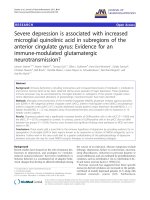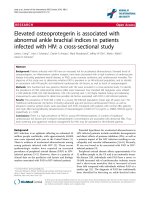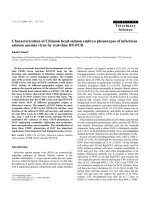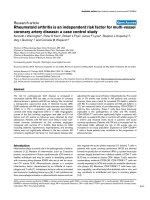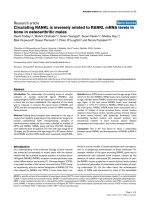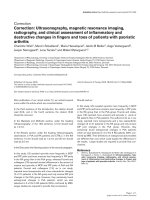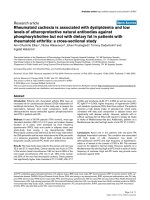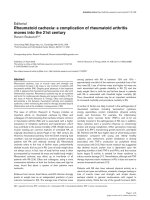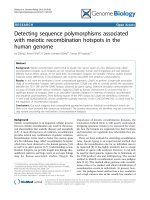Báo cáo y học: "Rheumatoid cachexia is associated with dyslipidemia and low levels of atheroprotective natural antibodies against phosphorylcholine but not with dietary fat in patients with rheumatoid arthritis: a cross-sectional study" pdf
Bạn đang xem bản rút gọn của tài liệu. Xem và tải ngay bản đầy đủ của tài liệu tại đây (209.24 KB, 11 trang )
Open Access
Available online />Page 1 of 11
(page number not for citation purposes)
Vol 11 No 2
Research article
Rheumatoid cachexia is associated with dyslipidemia and low
levels of atheroprotective natural antibodies against
phosphorylcholine but not with dietary fat in patients with
rheumatoid arthritis: a cross-sectional study
Ann-Charlotte Elkan
1
, Niclas Håkansson
2
, Johan Frostegård
3
, Tommy Cederholm
4
and
Ingiäld Hafström
1
1
Karolinska Institute at the Department of Rheumatology, Karolinska University Hospital Huddinge, 141 86 Stockholm, Sweden
2
The National Institute of Environmental Medicine, Division of Nutritional Epidemiology, Karolinska Institute, 171 77 Stockholm, Sweden
3
Karolinska Institute at the Department of Medicine, Karolinska University Hospital Huddinge, 141 86 Stockholm, Sweden
4
Department of Public Health and Caring Science/Clinical Nutrition and Metabolism, Uppsala University, 751 85 Uppsala, Sweden
Corresponding author: Ann-Charlotte Elkan,
Received: 23 Jan 2009 Revisions requested: 20 Feb 2009 Revisions received: 24 Feb 2009 Accepted: 10 Mar 2009 Published: 10 Mar 2009
Arthritis Research & Therapy 2009, 11:R37 (doi:10.1186/ar2643)
This article is online at: />© 2009 Elkan et al.; licensee BioMed Central Ltd.
This is an open access article distributed under the terms of the Creative Commons Attribution License ( />),
which permits unrestricted use, distribution, and reproduction in any medium, provided the original work is properly cited.
Abstract
Introduction Patients with rheumatoid arthritis (RA) have an
increased risk for cardiovascular disease (CVD) independent of
traditional risk factors. The aim of this study was to analyze the
associations between diet, body composition, lipids and
atheroprotective natural antibodies against phosphorylcholine
(anti-PC) in patients with RA.
Methods A total of 80 RA patients (76% women), mean age
(standard deviation (SD)) 61.4 (12) years and median disease
duration of 6 years, were assessed by food frequency
questionnaire (FFQ), fatty acid profile in adipose tissue and
whole-body dual energy x ray absorptiometry (DXA).
Rheumatoid cachexia was defined as fat free mass index below
the 25th percentile and fat mass index above the 50th percentile
of a reference population. Blood lipids, oxidized low-density
lipoprotein (oxLDL) and anti-PC levels were determined.
Results The mean body mass index for the women and men was
25.0 and 27.0, respectively. Central obesity was found in 57%
of the women (waist circumference >80 cm) and in 89% of the
men (waist circumference >94 cm). In all, 18% of the women
and 26% of the men had rheumatoid cachexia. These patients
had significantly higher total cholesterol (P < 0.033), LDL (P <
0.029), and trendwise oxLDL (P = 0.056) as well as lower anti-
PC IgM (P = 0.040), higher frequency of hypertension (69%)
and metabolic syndrome (25%) than those without. The patients
reported a high dietary intake of saturated fat, which partly
correlated with fatty acid composition in adipose tissue and
significantly with disease activity. However, patients with or
without cachexia did not differ with respect to dietary fat intake
or intake of Mediterranean-like diet. Additionally, patients on a
Mediterranean-like diet had high levels of anti-PC (P < 0.001).
Conclusions About one in five patients with low-active RA
displayed rheumatoid cachexia. This condition was associated
with high levels of LDL cholesterol, low levels of
atheroprotective anti-PC and high frequency of hypertension,
which is of interest in the context of CVD in RA. The cachexia
could not be related to diet fat intake. However, patients on a
Mediterranean-like diet had high anti-PC levels in spite of similar
frequency of cachexia. High anti-PC levels may provide some
protection against CVD.
Anti-PC: antibodies against phosphorylcholine; AT: adipose tissue; BMI: body mass index; BP: blood pressure; CRP: C-reactive protein; CVD: car-
diovascular disease; DAS28: 28-joint Disease Activity Score; DXA: dual energy x ray absorptiometry; ESR: erythrocyte sedimentation rate; FA: fatty
acid; FFM: fat free mass; FFMI: fat free mass index; FFQ: food frequency questionnaire; FM: fat mass; FMI: fat mass index; HAQ: Health Assessment
Questionnaire; HDL: high-density lipoprotein; IDF: International Diabetes Federation; LDL: low-density lipoprotein; MetS: metabolic syndrome; MUFA:
monounsaturated fatty acids; oxLDL: oxidized low-density lipoprotein; PC: phosphorylcholine; PUFA: polyunsaturated fatty acid; RA: rheumatoid
arthritis; SFA: saturated fatty acids; WC: waist circumference.
Arthritis Research & Therapy Vol 11 No 2 Elkan et al.
Page 2 of 11
(page number not for citation purposes)
Introduction
Rheumatoid arthritis (RA) is a chronic systemic inflammatory
disease with higher mortality rates than observed in the gen-
eral population [1,2]. This increased mortality is largely attrib-
uted to cardiovascular disease (CVD) [3]. The increase of
CVD is suggested to be related to the effects of the chronic
inflammation on the vascular endothelium, mainly through dys-
regulation of lipid metabolism.
Growing evidence points to inflammation in RA being associ-
ated with a worsening of the lipid profile [4,5], a factor already
present early in the disease [6]. Dyslipidemia in RA is mainly
presented by low concentrations of high-density lipoprotein
(HDL), which is associated with an unfavorable cardiovascular
risk. Total cholesterol and HDL levels in RA are inversely asso-
ciated with the acute phase response, regardless of whether
patients are treated with antirheumatic drugs or not. Further-
more, patients with RA have increased levels of oxidized low-
density lipoprotein (oxLDL) in serum compared with healthy
subjects, which may contribute to the increased risk of CVD in
this patient group [7] as LDL oxidation probably has an impor-
tant role in the pathogenesis of atherosclerosis [8].
Phosphorylcholine (PC) is a major ligand in oxLDL, exposed on
platelet activating factor (PAF)-like phospholipids, which pro-
mote inflammation [9]. Antibodies against PC (anti-PC) of the
IgM subclass are inversely associated with development of
atherosclerosis in patients with established hypertension [10].
Further, low levels of anti-PC antibodies are associated with
an increased risk of development of CVD [11].
In RA, anti-PC have not been studied in relation to CVD but we
have recently shown that the level of anti-PC in serum
increased when changing from a normal to a gluten-free vegan
diet [12].
Another consequence of the course of RA disease is change
in body composition, with reduced fat free mass (FFM), of
which muscle mass is the largest component [13,14]. The
decline in FFM is, in RA, often associated with increased fat
mass (FM) and thus, with little or no weight loss, also with a
maintained body mass index (BMI) [15,16]. This condition has
been named 'rheumatoid cachexia' [13] and is believed to
accelerate morbidity and mortality in RA [17].
Rheumatoid cachexia has been described in up to two thirds
of RA patients and is suggested to be caused by cytokine-
driven hypermetabolism and protein degradation [14,18].
However, it has also been found in patients with good disease
control [14]. Another proposed cause is poor nutrition [19].
Dietary intake appears to be adequate in terms of energy and
protein among patients with RA [18,20]. However, inadequate
nutrient intake has also been reported [21,22]. Further sup-
port for a role of diet in the context of rheumatoid cachexia can
be found in a recent report that addition of high dose oral
amino acids for 12 weeks increased FFM in RA patients with
rheumatoid cachexia [23].
During the last decade the use of food frequency question-
naires (FFQs) has become increasingly common to assess
long-term dietary consumption. The accuracy of these has
been proven in healthy individuals in terms of long-term dietary
fat consumption, as this corresponds to fatty acid (FA) compo-
sition in adipose tissue [24-27].
The purpose of this study was to analyze if the type of diet over
the previous year, determined by FFQ, was associated with
body composition derangement and dyslipidemia in patients
with RA. As a secondary goal, we also wanted to evaluate how
rheumatoid cachexia relates to cardiovascular risk factors.
Materials and methods
Patients
A total of 80 consecutive outpatients with RA at the Rheuma-
tology Department, Karolinska University Hospital Huddinge,
Stockholm, Sweden were included in the study. Eligible
patients were aged 18 to 80 years, had a diagnosis of RA [28]
and had disease duration of ≥ 1 year. The exclusion criteria
were: current malignancy, severe heart failure according to the
New York Heart Association (NYHA) classification >3 [29],
severe renal failure (glomerular filtration rate (GFR) <20 ml/
min), chronic obstructive lung disease with emphysema, ear-
lier gastric ulcer or intestinal surgery, known eating disorder or
steroid injections within 2 weeks. The patient characteristics
are shown in Table 1. Consequently, the patients had a fairly
low disease activity according to mean Disease Activity Score
(DAS28) [30] and a good functional ability as registered by
Health Assessment Questionnaire (HAQ) [31]. Furthermore,
54% of the women and 68% of the men had hypertension,
defined as a blood pressure above 140/90 or treatment with
antihypertensive drugs [32].
The study was approved by the Ethics committee at Karolinska
Institute, Stockholm, Sweden (reference number 2006/593-
31/2), and was performed in accordance with the Helsinki
declaration. Before entering the study the patients were given
oral and written information, after which we received written
informed consent from the patients.
Dietary assessment
The self-administered, semiquantitative FFQ was designed to
classify individuals according to levels of average daily intake
of selected nutrients from food and dietary supplements [33].
Participants were asked to report their frequency of use of 88
food items over the past year. There were nine possible fre-
quency categories in increasing order from never or almost
never to three times per day. Furthermore, there were open-
ended questions about the quantity of some food items eaten
daily by most Swedes; for example, milk, bread, coffee, and
cheese [33]. The nutrient calculations were carried out using
Available online />Page 3 of 11
(page number not for citation purposes)
nutrient composition values from the Swedish National Food
Administration data [34]. The intake of nutrients was com-
puted by multiplying the frequency of consumption of each
food item by the nutrient content of the specified portions.
According to the Swedish National Food Administration the
proportions (energy percentage (E%)) of carbohydrate, pro-
tein and fat should be 55 to 65 E%, 10 to 15 E% and 25 to
35 E%, respectively, for normally active individuals. For less
active individuals the recommendations are 55 E%, 16 E%
and 28 E%, respectively [35]. A Mediterranean diet was
defined as a diet with high intake of fruits, vegetables, leg-
umes, nuts, olive oil, fish, shellfish, a minimum of dairy products
and lean meat [33].
Biochemical measures
Venous blood samples were drawn between 07:30 and 10:00
after an overnight fast. The biochemical variables were deter-
mined by standard laboratory methods with commercial kits.
They included: C-reactive protein (CRP), erythrocyte sedimen-
tation rate (ESR), plasma glucose, total cholesterol, LDL, HDL
and triglycerides. The serum lipid concentrations were consid-
ered pathological when total cholesterol was >5.0 mmol/l,
LDL ≥ 3.0 mmol/l, triglycerides ≥ 1.7 mmol/l, for women HDL
<1.3 mmol/l and for men HDL <1.1 mmol/l.
The samples had also been stored at -70 C before analyses.
OxLDL was determined by use of a commercial kit (Mercodia,
Uppsala, Sweden) as per the manufacturer's instructions.
Anti-PC IgM was also determined by use of a commercial kit
(Athera CVDefine, Stockholm, Sweden) as per the manufac-
turer's instructions.
Subcutaneous abdominal fat cells were aspirated with a nee-
dle attached to a vacuum tube and stored at -70 C until ana-
lyzed. The FA composition of subcutaneous adipose tissue
was analyzed by gas liquid chromatography as described pre-
viously [36]. The amounts of FA were given as the relative per-
centage of the sum of the FA analyzed.
Body composition and metabolic syndrome
BMI was calculated from weight/height
2
(kg/m
2
). In accord-
ance with World Health Organization (WHO) standards, indi-
viduals with BMI values <18.5 kg/m
2
are considered
underweight, between 18.5 to 24.9 as normal, 25 to 29.9 as
overweight and values greater than 30 indicate obesity [37].
Waist circumference (WC) was measured to identify centrally
obese individuals. Waist was measured to the nearest 0.5 cm
midway between the iliac crest and the lower rib margin.
According to the International Diabetes Federation (IDF), a
waist circumference value less than 80 cm in women and 94
cm in men indicates low risk, 80–87.9 cm in women and
94–101.9 cm in men indicates intermediate risk, and a value
Table 1
Patient characteristics
Women (n = 61) Men (n = 19)
Age, years 60.8 (57.3 to 64.4) 63.4 (59.8 to 66.9)
Disease duration, years
a
6.0 (2.0 to 15.0) 5.0 (3.0 to 9.0)
Rheumatoid factor positive, N (%) 51 (84) 14 (74)
Erosive disease, N (%) 47 (77) 14 (74)
ESR, mm/h
a
16.0 (9.0 to 29.0) 12.0 (9.0 to 15.0)
C-reactive protein, mg/l
a
2.0 (1.0 to 8.0) 3.0 (1.0 to 9.0)
DAS28 3.3 (3.0 to 3.6) 2.6 (2.1 to 3.0)
HAQ score (0 to 3) 0.7 (0.5 to 0.8) 0.5 (0.2 to 0.7)
Patients on DMARDs, N (%) 59 (97) 19 (100)
Patients on glucocorticoids, N (%) 17 (28) 3 (16)
Glucocorticoids, dose, mg 4.3 (3.4 to 5.3) 4.2 (0.6 to 7.8)
Hypertension, N (%) 33 (54) 13 (68)
MetS, N (%) 12 (20) 12 (63)
Data is presented as mean (95% confidence intervals) for normally distributed variables and as median (interquartile range) for non-parametric
variables.
a
Median.
DAS28, 28-joint Disease Activity Score (where a value of >5.1 is regarded as high disease activity, <3.2 is regarded as low activity and <2.6 is
regarded as remission); ESR, erythrocyte sedimentation rate; DMARD, disease-modifying antirheumatic drug (for example, methotrexate,
sulfasalazine, hydroxychloroquine, cyclosporine, natriumaurotiomalat and azathioprine); HAQ, Health Assessment Questionnaire; MetS, metabolic
syndrome.
Arthritis Research & Therapy Vol 11 No 2 Elkan et al.
Page 4 of 11
(page number not for citation purposes)
above 88 cm in women and 102 cm in men high risk of type 2
diabetes, coronary heart disease or hypertension [38].
Metabolic syndrome (MetS) was defined according to the IDF
[38]; that is, presence of central obesity (waist perimeter ≥ 80
cm in females and ≥ 94 cm in males) plus two of the following
four criteria: hypertriglyceridemia (triglycerides ≥ 1.7 mmol/1
or specific treatment), unfavorable HDL level (<1.3 mmol/1 in
females and <1.1 mmol/1 in males and or specific treatment),
hypertension (systolic blood pressure (BP) ≥ 130 mmHg or
diastolic BP ≥ 85 mmHg or specific antihypertensive treat-
ment) and fasting plasma glucose ≥ 5.6 mmol/1 or prior diag-
nosis of type 2 diabetes mellitus.
Body composition was measured with total body dual energy
x ray absorptiometry (DXA) (GE-Lunar Prodigy, software
enCore 2006, v. 10.20.105, Madison, Wisconsin, USA,). FFM
and FM were expressed in absolute kg, and FM also as per-
centage of total mass. The reference value for FM% is 20% to
30% for women and 12% to 20% for men [39].
Fat free mass index (FFMI, kg/m
2
) and fat mass index (FMI, kg/
m
2
) were also calculated. Age-matched and sex-matched data
from a Swiss population of healthy adults (2,986 men and
2,649 women) were used to classify low FFM or excess FM
[40]. The cutoff value for low FFM was defined as FFMI below
the 10th percentile and obesity was defined as FMI above the
90th percentile, as defined by the reference population [40].
As there is no established criterion for rheumatoid cachexia we
used both the definition by Engvall et al., who categorized the
patients as rheumatoid cachectic if FFMI was below the 10th
percentile and FMI above the 25th percentile [41], and also
the definition composed of FFMI below the 25th percentile
and FMI above the 50th percentile.
Statistical analysis
Data were presented as mean (confidence interval) or median
(interquartile range) depending on whether the data were nor-
mally distributed or not. Differences between patient groups
were assessed using the Student t test and Mann-Whitney U
test, depending on the distribution of the analyzed variable.
To evaluate the association between intake of fatty acids in the
diet and their relative content in adipose tissue Spearman cor-
relations were used.
Table 2
Energy intake according to food frequency questionnaire (FFQ) in rheumatoid arthritis (RA) patients and Swedish
recommendations for low active individuals
Women with RA (n = 61) Recommendations for females Men with RA (n = 19) Recommendations for males
Energy, kcal 1,668 (1,537 to 1,799) 2,200 2,402 (2,123 to 2,680) 2,700
Carbohydrate, g 195 (178 to 212) 293 268 (238 to 298) 369
Carbohydrate, E% 48 55 45 55
Protein, g 73.0 (66.7 to 79.3) 86 103 (88.4 to 118) 107
Protein, g/kg 1.13 (1.01 to 1.23) 1.18 (1.0 to 1.36)
Protein, E% 18 16 17 16
Total fat, g 61.1 (55.8 to 66.4) 69 88.6 (75.1 to 102.1) 87
Total fat, E% 33 28 33 28
SFA, g 26.4 (23.7 to 29.0) 20 39.1 (31.9 to 46.2) 30
SFA, E% 14 10 15 10
MUFA, g 21.0 (19.2 to 22.8) 30 30.9 (26.5 to 35.2) 40
MUFA, E% 11 11 12 11
PUFA, g 8.9 (7.9 to 9.8) 15 to 30 11.8 (9.8 to 13.8) 15 to 30
PUFA, E% 4.8 5 4.4 5
Omega 3 FA, g 1.9 (1.8–2.1) ≥ 3.0 1.7 (1.6–1.8) ≥ 3.0
Omega 3 FA, E% 1.0 1.3 0.6 1.3
Omega 6 FA, g 6.9 (6.2 to 7.7) 10.8 11.0 (10.4 to 11.5) 10.8
Omega 6 FA, E% 3.7 3.6 4.1 3.6
E%, energy percentage; FA, fatty acid; MUFA, monounsaturated fatty acid; PUFA, polyunsaturated fatty acid; SFA, saturated fatty acid.
Available online />Page 5 of 11
(page number not for citation purposes)
FAs in adipose tissue are described as the percentage of the
total FAs analyzed. Dietary FAs are described as the percent-
age of total fat intake as well as grams per day.
P values < 0.05 were considered significant. The statistical
analysis program Statistica 7 (Stat Soft Scandinavia AB, Upp-
sala, Sweden), was used for statistical analysis.
Results
Dietary intake and fatty acid profiles
The mean dietary intake of total energy, carbohydrate, protein
and fat is shown in Table 2. Compared with the Swedish Food
Recommendations for individuals with low physical activity
[35], the RA patients had a low intake of total energy. As to the
diet composition, the patients reported lower carbohydrate
intake and higher fat intake than recommended. The fat intake
consisted of more saturated and less unsaturated fat than rec-
ommended.
Low total energy intake was mainly reported by patients with
moderate inflammatory activity. Thus, female patients with
DAS28 >3.2 had a lower mean energy intake than those with
DAS28 ≤ 3.2 (1,500 kcal/day vs. 1,800 kcal/day, P = 0.016).
The proportions (E%) of carbohydrate, protein and fat were
similar in these two groups. Saturated fatty acid (SFA) intake
was significantly associated with DAS28 (r = 0.26, P =
0.017).
In all, 65 patients (81%) reported eating a normal western diet
(46 of the women and all of the men), 3 patients (all women)
were vegetarians and 12 (all women) followed a Mediterra-
nean-like diet. The reported dietary intake of FAs correlated
significantly with that in adipose tissue as to FA 14:0 (myristic
acid), 18:2 n-6 (linoleic acid), 18:3 n-3 (α-linolenic acid), 20:4
n-6 (arachidonic acid), 20:5 n-3 (eicosapentaenoic acid), 22:5
n-3 (docosapentaenoic acid) and 22:6 n-3 (docosahexaenoic
acid), but not with 16:0 (palmitic acid) and 18:1 n-9 (oleic
acid) (Table 3). The FA in adipose tissue consisted predomi-
nantly of 18:1 n-9 (oleic acid) 51%, 16:0 (palmitic acid), 22%
and 18:2 n-6 (linoleic acid) 11%.
When analyzing the adipose FA content for the different self-
reported diet groups, it was found that subjects compliant to
Mediterranean-like or vegetarian diets had a more favorable FA
profile; that is, with higher polyunsaturated fatty acids (PUFAs)
than those reporting to eat a normal Western diet, Table 4.
Serum lipids and anti-PC IgM
Lipid mean values for women with RA with normal Western
diet and with the Mediterranean-like/vegetarian diets are pre-
sented in Table 4. There were no significant differences
between the diet groups. A total of 53% of the women and
32% of the men had cholesterol >5.0 mmol/l. Low HDL levels
were found in 3% of the women and 5% in the men. High LDL
levels were present in 51% of the women and in 32% of the
men. Corresponding figures for triglycerides were 1% and
37% respectively. Concerning oxLDL, no reference values
exist.
However, anti-PC IgM levels differed significantly between
patients in the different self-reported diet groups. Women with
Mediterranean-like diet had significantly higher median level
compared with those with self-reported normal Western diet
(p < 0.001), Table 4.
Anthropometrical assessments and body composition
measurement
As shown in Table 5 the change in body weight from start of
RA disease to the present investigation was fairly small for
both sexes. BMI indicated that both women and men were
overweight. Only one of the patients had BMI <18.5. A total of
55% of the patients had a BMI >25. Central obesity was found
in 57% of the women (WC >80 cm) and in 89% of the men
(WC >94 cm). In all, 20% of the women and 63% of the men
could be diagnosed to have MetS according to IDF guidelines
[38].
Body composition data are shown in Table 5. In all, 31% of the
women and 53% of the men had a FMI above the 90th percen-
tile of the reference population, implying that they could be
classified as obese. Reduced FFMI, that is, below the 10th
percentile of a reference population, was registered in 26%
and 21% of the women and men, respectively. Furthermore,
18% of the women and 26% of the men were assessed to
have rheumatoid cachexia when using the definition of FFMI
below the 25th percentile and FMI above the 50th percentile.
By the definition of FFMI below the 10th percentile and FMI
above the 25th percentile, 18% and 21% of the women and
men, respectively, were assessed to have rheumatoid
cachexia. FFM correlated with disease duration (r = -0.30, p =
0.008), in contrast to FM.
Relationship between body composition and serum
lipids as well as anti-PC antibodies and inflammatory
markers
Patients with low FFMI, below the 10th or the 25th percentile
of healthy adults, had serum lipid and anti-PC levels similar to
the rest of the patients [Additional data file 1]. Patients with
FMI above the 50th percentile had lower HDL and higher trig-
lycerides than the other patients. When combining low FFMI
and high FMI according to the two proposed definitions of
rheumatoid cachexia, it was evident that the patients with FFMI
<25th percentile in combination with FMI >50th percentile
had higher LDL, cholesterol and trendwise oxLDL, as well as
significantly lower values of anti-PC IgM (p = 0.040), than
those without this derangement in their body composition.
With regard to DAS28 and CRP, there were no significant dif-
ferences between any of the body composition groups (as
defined in [Additional data file 1]) and those not belonging to
Arthritis Research & Therapy Vol 11 No 2 Elkan et al.
Page 6 of 11
(page number not for citation purposes)
the respective group. However, when separating the patients
according to the DAS28 level it was found that patients with
DAS28 ≥ 3.2 had significantly higher FM% (38.0 vs. 35.3, p =
0.032), lower FFM (43.5 vs. 48.5 kg, p = 0.018) and lower
FFM/FM ratio (1.6 vs. 2.1, p = 0.031) than those with DAS28
≤ 3.2.
Relationship between body composition and diet groups
as well as presence of hypertension and MetS
There were no significant differences in intake of energy or fat
(total SFA or total PUFA, also separated by total omega 3 and
omega 6) between those who were considered to have rheu-
matoid cachexia or not, irrespective of definition. Neither did
the frequency of patients with the self-reported Mediterranean
and vegetarian diets differ between these groups (data not
shown).
Patients with FMI above the 50th percentile and patients with
rheumatoid cachexia, defined as FFMI <25th percentile in
combination with FMI >50th percentile, had the highest fre-
quencies of hypertension and MetS [Additional data file 1].
Furthermore, we found that patients with hypertension had sig-
nificantly lower values of anti-PC IgM, median (interquartile
range (IQR)) of 39.9 (30.1 to 73.8), than those with normal
blood pressure, median (IQR) of 54.5 (41.6 to 160.7) (p =
0.046). Treatment with glucocorticoids and mean dose given
did not differ between those who were cachectic and those
not (data not shown).
Discussion
This study shows that ambulatory patients with RA of low dis-
ease activity were reported to have a diet intake high in satu-
rated fat. They were in general centrally obese and a fifth had
rheumatoid cachexia. A large proportion of the patients had
hypertension and MetS, especially those with high FM and
rheumatoid cachexia, conditions associated with high levels of
oxLDL and low levels of anti-PC. Patients compliant with Med-
iterranean and vegetarian diets did not differ in body composi-
tion from the rest of the patients, but had a higher content of
PUFA in adipose tissue and significantly higher serum levels of
the atheroprotective anti-PC.
The patients had, according to the FFQ, a lower than recom-
mended caloric intake. It is unclear if this was a real difference
or a consequence of underreporting. However, underreporting
seems most probable as earlier comparisons between FFQ
and weighed diet records concerning fat intake showed lower
total intake registered by FFQ than the weighed diet, whereas
the proportions of fat components were similar [27].
With regard to the caloric proportions of the diet, our patients
had a higher intake of saturated fat and lower intake of unsatu-
rated fat compared to the Food Recommendations in Sweden
[35]. A high fat intake has also been noted in RA patients in
the USA, of which 40% were obese [21].
The reliability of the long-term fatty acid intake according to the
FFQ was verified by the significant correlations found between
the PUFAs ingested and those in adipose tissue. PUFAs in
adipose tissue are largely exogenous and hence valid markers
to assess dietary intake [42,43]. By contrast, SFAs and
monounsaturated fatty acids (MUFAs) are not considered to
be good biomarkers of intake because they are also endog-
enously synthesized [42,44], which was evident in the RA
patients with no significant correlations concerning 16:0 and
18:1 n-9. Furthermore, the noted significant correlation
between 14:0 FA in diet and adipose tissue verifies a report by
Wolk et al. that this FA is also a valid biomarker for FA intake
[45].
Table 3
Spearman correlation coefficients between relative (% of total fat) fatty acid (FA) diet intake calculated from food frequency
questionnaire (FFQ) and FA in adipose tissue
14:0 (FFQ) 16:0 (FFQ) 18:1 n9
(FFQ)
18:2 n6
(FFQ)
18:3 n3
(FFQ)
20:4 n6
(FFQ)
20:5 n3
(FFQ)
22:5 n3
(FFQ)
22:6 n3
(FFQ)
14:0, AT 0.27**
16:0, AT -0.12
18:1 n9, AT 0.21
18:2 n6, AT 0.50*
18:3 n3, AT 0.48*
20:4 n6, AT 0.64*
20:5 n3, AT 0.71*
22:5 n3, AT 0.78*
22:6 n3, AT 0.82*
*P < 0.001, **P < 0.05
AT = adipose tissue.
Available online />Page 7 of 11
(page number not for citation purposes)
When comparing the proportions of FAs in the adipose tissue
in our RA patients with healthy subjects from different coun-
tries (Sweden, Denmark, USA, Spain and Costa Rica), our RA
patients had higher proportions of SFA and lower proportions
of PUFA than healthy subjects from the above-mentioned
countries [25,42,43,46,47]. However, the SFA and PUFA
content of adipose tissue was similar to that described in RA
patients from the south of Sweden [48].
The patients reported in general a high intake of saturated fat.
This high intake was also reflected in the FA composition of
the adipose tissue. However, we did not find that the FA intake
differed between cachectic and non-cachectic patients.
Adherence to a Mediterranean diet did not differ either
between cachectic and non-cachectic patients. Thus, diet as
analyzed here does not seem to cause the derangement of
body composition leading to cachexia. This finding is in
accordance with the known difficulties of treating cachexia
with diet. However, recently supplements with amino acids
have been shown to increase muscle mass [23]. By contrast,
the high intake of dietary fat may have contributed to the dysl-
ipidemia displayed by the patients.
With regard to dietary therapies, 33% to 75% of RA patients
believe that food plays an important role in their disease, and
20% to 50% have tried dietary manipulation in an attempt to
relieve symptoms [49,50]. The present finding that dietary
intake of SFAs was significantly associated with disease activ-
ity focuses on the immunosuppressive effect of unsaturated
FAs. In the scientific community there is, however, no consen-
sus on dietary recommendations to patients with RA. Evidence
may emerge that, for patients at an advanced disease stage, a
high-protein diet may be recommended and, for patients with
early RA, restriction of excessive energy intake may be benefi-
Table 4
Fatty acids in adipose tissue and serum levels of lipids and anti-PC IgM in women with rheumatoid arthritis (RA), separated for diet
Normal diet (n = 46) Mediterranean-like diet (n = 12) P value Mediterranean-like and vegetarian diets (n =
15)
P value
Adipose tissue:
SFA 29.2 (28.4 to 29.9) 29.1 (27.5 to 30.7) 0.60 28.8 (27.5 to 30.1) 0.90
14:0 3.3 (3.1 to 3.5) 3.4 (3.1 to 3.8) 0.60 3.5 (3.2 to 3.8) 0.43
16:0 21.7 (21.2 to 22.2) 21.7 (20.4 to 23.1) 0.92 21.4 (20.2 to 22.5) 0.55
MUFA 57.4 (56.7 to 58.1) 56.1 (54.6 to 57.6) 0.06 55.8 (54.4 to 57.2) 0.016
16:1 n7 6.5 (6.0 to 6.9) 6.0 (5.3 to 6.6) 0.30 5.8 (5.2 to 6.4) 0.13
18:1 n9 51.4 (50.9 to 52.0) 50.2 (48.9 to 51.2) 0.05 50.0 (49.0 to 51.0) 0.019
Omega 3 1.8 (1.7 to 1.9) 2.1 (1.7 to 2.6) 0.039 2.2 (1.8 to 2.6) 0.009
18:3 n3 1.1 (1.0 to 1.2) 1.1 (0.93 to 1.2) 0.72 1.1 (1.0 to 1.3) 0.22
20:5 n3 0.14 (0.12 to 0.16) 0.19 (0.12 to 0.25)* 0.08 0.15 (0.11 to 0.25)* 0.16
22:5 n3 0.33 (0.29 to 0.37) 0.40 (0.31 to 0.50) 0.06 0.39 (0.29 to 0.48) 0.11
22:6 n3 0.32 (0.28 to 0.36) 0.47 (0.25 to 0.59)* 0.07 0.47 (0.20 to 0.60)* 0.13
Omega 6 11.0 (10.6 to 11.3) 12.0 (10.7 to 13.2) 0.06 12.6 (11.2 to 14.1) 0.004
18:2 n6 10.1 (9.7 to 10.5) 11.2 (9.8 to 12.5) 0.06 11.9 (10.4 to 13.4) 0.003
20:4 n6 0.40 (0.36 to 0.44) 0.39 (0.31 to 0.46) 0.81 0.32 (0.26 to 0.45)* 0.35
Serum lipids:
Cholesterol, mmol/l 5.3 (5.0 to 5.6) 5.1 (4.7 to 5.6) 0.60 5.1 (4.8 to 5.5) 0.57
HDL, mmol/l 1.9 (1.7 to 2.0) 1.9 (1.4 to 2.4) 0.97 1.9 (1.5 to 2.3) 0.86
LDL, mmol/l 2.9 (2.7 to 3.2) 2.8 (2.3 to 3.2) 0.58 2.8 (2.3 to 3.2) 0.52
OxLDL, U/l 62.1 (55.7 to 68.4) 59.4 (50.0 to 68.9) 0.67 58.8 (51.2 to 66.3) 0.57
Triacylglycerol, mmol/l 0.98 (0.88 to 1.1) 1.0 (0.82 to 1.2) 0.63 1.0 (0.81 to 1.1) 0.95
anti-PC IgM, U/ml
a
43.5 (30.3 to 65.5) 198.2 (171.6 to 209.2) <0.001 188.2 (63.3 to 208.1) <0.001
Values are means (95% confidence interval) and
a
medians (interquartile range). The fatty acids in adipose tissue are expressed as a percentage of
total fat. Significant results are in bold.
Anti-PC IgM, antibodies against phosphorylcholine IgM; FA, fatty acid; HDL< high-density lipoprotein; LDL, low-density lipoprotein; MUFA,
monounsaturated fatty acid; oxLDL, oxidized low-density lipoprotein; PUFA, polyunsaturated fatty acid; SFA, saturated fatty acid.
Arthritis Research & Therapy Vol 11 No 2 Elkan et al.
Page 8 of 11
(page number not for citation purposes)
cial to prevent obesity [51]. A scientific basis for a role of die-
tary therapy in RA has grown in the last few years, although
there is still no agreement on the nature of the optimum diet
[52].
Several of the RA patients had dyslipidemia, hypertension and
MetS, most frequently patients with high FM and rheumatoid
cachexia. Of the lipids, oxLDL might be especially important as
it has proinflammatory and immune stimulatory properties
[53,54]. It has previously been detected in synovia from RA
patients [55], and is suggested to be of importance in the
pathogenesis of CVD [8]. Even though there are no existing
reference values for oxLDL, the present patients had higher
levels than earlier reported for healthy people, with mean (SD)
values of 42.2 U/l (± 14.7) and mean (95% confidence interval
(CI)) 48 U/l (35 to 68) [7,56]. Additionally, when compared
with RA patients from Korea who had a mean (SD) value of
53.0 U/l (± 20.9) [7], our patients had higher levels, a differ-
ence that might be secondary to different diet habits.
One novel finding herein is that anti-PC levels decreased in
patients with rheumatoid cachexia. Low anti-PC levels could
predispose patients to cardiovascular disease [10,11] and
might thus be one explanation for the increased morbidity in
rheumatoid cachexia. The cause of this association is not
known.
Also, the very high levels of anti-PC in patients on a Mediterra-
nean diet is of great interest, as patients on this diet are
reported to have a lower frequency of CVD [57,58]. In RA anti-
PC have not been studied in relation to CVD, but we have
recently shown that the levels of anti-PC in serum increased in
RA patients when changing from a normal Western diet to a
gluten-free vegan diet [12]. The present finding adds strength
to our previous report, indicating that diet may influence
atheroprotective anti-PC in RA.
A high frequency of MetS has previously been reported in RA
patients [59-61]. In these patients an association between
MetS and disease activity, as well as coronary calcification,
has been shown [60,61], suggesting that the increased prev-
alence of coronary heart disease in RA patients may, at least
in part, be attributed to inflammation and change of fat metab-
olism.
In the present RA population every fourth to fifth patient had
rheumatoid cachexia, irrespectively of which of the two defini-
tions for cachexia were used. There is no standard definition of
this condition as reviewed by Summers et al. [62], which is
why the frequency of rheumatoid cachexia varies. The
cachexia and muscle wasting found here could not reflect the
changes in body composition that occur with age [63], as the
reference population was matched for age and sex [40]. Age-
related muscle wasting is a separate condition named sarco-
penia. Cachexia in chronic inflammatory diseases is sug-
gested to be associated with increased morbidity [19]. Mostly,
the morbidity has been attributing the loss of body lean mass
[13], whereas the coincidental increase of fat mass has not
been considered in this context. In the present study it was
obvious that FM above the 50th percentile was, together with
FFM below the 25th percentile, associated with dyslipidemia
as were increased levels of total cholesterol, LDL and oxLDL
and also low levels of anti-PC. These patients are therefore
suggested to have an increased risk of CVD and premature
mortality [10,11,64]. In fact, they also had high frequencies of
hypertension and MetS.
Low FFM alone, irrespective of FM, was not associated with
these risk factors for CVD. By contrast, only one of the patients
Table 5
Anthropometry and body composition measurement in rheumatoid arthritis (RA) patients
Women (n = 61) Men (n = 19)
Weight change since disease onset, kg 2.3 (-0.8 to 5.9) 4.4 (-2.2 to 8.0)
BMI, kg/m
2
25.0 (23.6 to 26.3) 27.0 (25.7 to 29.1)
Waist circumference, cm 85 (81 to 89) 105 (100 to 110)
Central obesity (WC >80 cm in women, >94 cm in men), N (%) 35 (57) 17 (89)
FM, total, kg 25.8 (22.8 to 28.7) 27.9 (23.4 to 32.5)
FM, total, % 37.8 (35.7 to 39.9) 31.7 (28.1 to 35.2)
FMI, kg/m
2
8.8 (6.5 to 11.4)
a
8.6 (7.2 to 9.9)
FFM, total, kg 42.0 (40.6 to 43.5) 61.2 (58.6 to 63.8)
FFMI, kg/m
2
15.5 (15.1 to 15.9) 18.9 (18.2 to 19.6)
Data is presented as mean (95% confidence interval) for normally distributed variables and as median (interquartile range) for non-parametric
variables.
a
Median
BMI, body mass index; FFM, fat free mass; FFMI, fat free mass index; FM, fat mass; FMI, fat mass index; WC, waist circumference.
Available online />Page 9 of 11
(page number not for citation purposes)
was severely emaciated with extremely low BMI known to be
associated with cardiovascular mortality in RA [65].
A large proportion of the patients were centrally obese, which
is in line with earlier reports [16]. This fact might contribute to
the increased presence of risk factors for CVD in the patients
with rheumatoid cachexia.
In the present cohort of patients we did not find that DAS28
or CRP differed between those with cachexia and the rest of
the patients, probably related to the fact that most patients had
low inflammatory activity. However, when separating the
patients into those with low DAS28 and those with DAS28
corresponding to moderate activity it was found that the latter
had lower FFM and higher FM than the former. Thus, the
inflammation per se might have contributed to the derange-
ment in body composition found here and also described pre-
viously [18,41,66]. A further explanation could be that patients
with DAS28 of moderate activity reported lower energy intake
than those with low activity.
Conclusion
In our cohort of RA patients with low disease activity and BMI
in the upper reference range every fourth to fifth patient had
rheumatoid cachexia, a condition that was not associated with
the observed increased intake of fatty acids. Rheumatoid
cachexia defined as FFMI below the 25th percentile and FMI
above the 50th percentile was associated with risk factors for
CVD, including raised cholesterol and LDL and also
decreased levels of the atheroprotective marker anti-PC as
well as a high frequency of hypertension. We thus propose
this definition of rheumatoid cachexia to be used, as it verifies
that it is associated with increased morbidity. However,
patients on a Mediterranean-like diet had high anti-PC levels in
spite of a similar frequency of cachexia, which may provide
some protection against CVD events.
Competing interests
The authors declare that they have no competing interests.
Authors' contributions
ACE was responsible for the design of the study, for all meas-
urements, for analyzing the data and was responsible for writ-
ing the manuscript. NH had responsibility for analyzing the
FFQ. JF was responsible for assays of lipids and anti-PC anti-
bodies. TC had an active role in the design of the study, in ana-
lyzing adipose tissue and an advisory role. IH took part in the
design of the study and has been senior advisor in all parts of
the research and manuscript preparation. All authors read and
approved the final manuscript.
Additional files
Acknowledgements
We are grateful to Inger Vedin for analyzing oxLDL and anti-PC antibod-
ies, and to Siv Tengblad for analyzing fatty acids in adipose tissue. This
work was supported by grants from The Swedish Rheumatism Associa-
tion, King Gustav V 80 years foundation, Capio, The Stig Thunes foun-
dation, the Swedish Research Council and the regional agreement on
medical training and clinical research (ALF) between Stockholm county
council and the Karolinska Institute.
References
1. Symmons DP: Mortality in rheumatoid arthritis. Br J Rheumatol
1988, 27(Suppl 1):44-54.
2. Naz SM, Symmons DP: Mortality in established rheumatoid
arthritis. Best Pract Res Clin Rheumatol 2007, 21:871-883.
3. Maradit-Kremers H, Nicola PJ, Crowson CS, Ballman KV, Gabriel
SE: Cardiovascular death in rheumatoid arthritis: a population-
based study. Arthritis Rheum 2005, 52:722-732.
4. Boers M, Nurmohamed MT, Doelman CJ, Lard LR, Verhoeven AC,
Voskuyl AE, Huizinga TW, Stadt RJ van de, Dijkmans BA, Linden S
van der: Influence of glucocorticoids and disease activity on
total and high density lipoprotein cholesterol in patients with
rheumatoid arthritis. Ann Rheum Dis 2003, 62:842-845.
5. Park YB, Choi HK, Kim MY, Lee WK, Song J, Kim DK, Lee SK:
Effects of antirheumatic therapy on serum lipid levels in
patients with rheumatoid arthritis: a prospective study. Am J
Med 2002, 113:188-193.
6. Georgiadis AN, Papavasiliou EC, Lourida ES, Alamanos Y, Kostara
C, Tselepis AD, Drosos AA: Atherogenic lipid profile is a feature
characteristic of patients with early rheumatoid arthritis: effect
of early treatment – a prospective, controlled study. Arthritis
Res Ther 2006, 8:R82.
7. Kim SH, Lee CK, Lee EY, Park SY, Cho YS, Yoo B, Moon HB:
Serum oxidized low-density lipoproteins in rheumatoid arthri-
tis. Rheumatol Int 2004, 24:230-233.
8. Binder CJ, Horkko S, Dewan A, Chang MK, Kieu EP, Goodyear
CS, Shaw PX, Palinski W, Witztum JL, Silverman GJ: Pneumococ-
cal vaccination decreases atherosclerotic lesion formation:
molecular mimicry between Streptococcus pneumoniae and
oxidized LDL. Nat Med 2003, 9:736-743.
9. Frostegard J, Huang YH, Ronnelid J, Schafer-Elinder L: Platelet-
activating factor and oxidized LDL induce immune activation
by a common mechanism. Arterioscler Thromb Vasc Biol 1997,
17:963-968.
10. Su J, Georgiades A, Wu R, Thulin T, de Faire U, Frostegard J: Anti-
bodies of IgM subclass to phosphorylcholine and oxidized
LDL are protective factors for atherosclerosis in patients with
hypertension. Atherosclerosis 2006, 188:160-166.
11. Sjoberg BG, Su J, Dahlbom I, Gronlund H, Wikstrom M, Hedblad
B, Berglund G, de Faire U, Frostegard J:
Low levels of IgM anti-
bodies against phosphorylcholine-A potential risk marker for
ischemic stroke in men. Atherosclerosis 2009 in press.
12. Elkan AC, Sjoberg B, Kolsrud B, Ringertz B, Hafstrom I, Frostegard
J: Gluten-free vegan diet induces decreased LDL and oxidized
LDL levels and raised atheroprotective natural antibodies
The following Additional files are available online:
Additional file 1
A table in Word format listing blood lipids, inflammatory
marker, hypertension and metabolic syndrome in relation
to different categories of body composition.
See />supplementary/ar2643-S1.doc
Arthritis Research & Therapy Vol 11 No 2 Elkan et al.
Page 10 of 11
(page number not for citation purposes)
against phosphorylcholine in patients with rheumatoid arthri-
tis: a randomized study. Arthritis Res Ther 2008, 10:R34.
13. Roubenoff R, Roubenoff RA, Ward LM, Holland SM, Hellmann DB:
Rheumatoid cachexia: depletion of lean body mass in rheuma-
toid arthritis. Possible association with tumor necrosis factor.
J Rheumatol 1992, 19:1505-1510.
14. Walsmith J, Abad L, Kehayias J, Roubenoff R: Tumor necrosis
factor-alpha production is associated with less body cell mass
in women with rheumatoid arthritis. J Rheumatol 2004,
31:23-29.
15. Elkan AC, Engvall IL, Tengstrand B, Cederholm T, Hafstrom I: Mal-
nutrition in women with rheumatoid arthritis is not revealed by
clinical anthropometrical measurements or nutritional evalua-
tion tools. Eur J Clin Nutr 2008, 62:1239-1247.
16. Westhovens R, Nijs J, Taelman V, Dequeker J: Body composition
in rheumatoid arthritis. Br J Rheumatol 1997, 36:444-448.
17. Walsmith J, Roubenoff R: Cachexia in rheumatoid arthritis. Int J
Cardiol 2002, 85:89-99.
18. Roubenoff R, Roubenoff RA, Cannon JG, Kehayias JJ, Zhuang H,
Dawson-Hughes B, Dinarello CA, Rosenberg IH: Rheumatoid
cachexia: cytokine-driven hypermetabolism accompanying
reduced body cell mass in chronic inflammation. J Clin Invest
1994, 93:2379-2386.
19. Akner G, Cederholm T: Treatment of protein-energy malnutri-
tion in chronic nonmalignant disorders. Am J Clin Nutr 2001,
74:6-24.
20. Gomez-Vaquero C, Nolla JM, Fiter J, Ramon JM, Concustell R, Val-
verde J, Roig-Escofet D: Nutritional status in patients with rheu-
matoid arthritis. Joint Bone Spine 2001, 68:403-409.
21. Morgan SL, Anderson AM, Hood SM, Matthews PA, Lee JY, Alar-
con GS: Nutrient intake patterns, body mass index, and vita-
min levels in patients with rheumatoid arthritis. Arthritis Care
Res 1997, 10:9-17.
22. Laar MA van de, Nieuwenhuis JM, Former-Boon M, Hulsing J, Korst
JK van der: Nutritional habits of patients suffering from serop-
ositive rheumatoid arthritis: a screening of 93 Dutch patients.
Clin Rheumatol 1990, 9:483-488.
23. Marcora S, Lemmey A, Maddison P: Dietary treatment of rheu-
matoid cachexia with beta-hydroxy-beta-methylbutyrate,
glutamine and arginine: a randomised controlled trial. Clin
Nutr 2005, 24:442-454.
24. Hunter DJ, Rimm EB, Sacks FM, Stampfer MJ, Colditz GA, Litin LB,
Willett WC: Comparison of measures of fatty acid intake by
subcutaneous fat aspirate, food frequency questionnaire, and
diet records in a free-living population of US men. Am J Epide-
miol 1992, 135:418-427.
25. Tjonneland A, Overvad K, Thorling E, Ewertz M: Adipose tissue
fatty acids as biomarkers of dietary exposure in Danish men
and women. Am J Clin Nutr 1993, 57:629-633.
26. Garland M, Sacks FM, Colditz GA, Rimm EB, Sampson LA, Willett
WC, Hunter DJ: The relation between dietary intake and adi-
pose tissue composition of selected fatty acids in US women.
Am J Clin Nutr 1998, 67:25-30.
27. Wolk A, Vessby B, Ljung H, Barrefors P: Evaluation of a biologi-
cal marker of dairy fat intake. Am J Clin Nutr 1998, 68:291-295.
28. Arnett FC, Edworthy SM, Bloch DA, McShane DJ, Fries JF, Cooper
NS, Healey LA, Kaplan SR, Liang MH, Luthra HS, Medsger TA Jr,
Mitchell DM, Neustadt DH, Pinals RS, Schaller JG, Sharp JT,
Wilder RL, Hunder GG: The American Rheumatism Association
1987 revised criteria for the classification of rheumatoid arthri-
tis. Arthritis Rheum 1988, 31:315-324.
29. Criteria Committee of the American Heart Association: Nomen-
clature and Diagnosis. 9th edition. New York, USA: American
Heart Association; 1994.
30. Prevoo ML, van 't Hof MA, Kuper HH, van Leeuwen MA, Putte LB
van de, van Riel PL: Modified disease activity scores that
include twenty-eight-joint counts. Development and validation
in a prospective longitudinal study of patients with rheumatoid
arthritis. Arthritis Rheum 1995, 38:44-48.
31. Ekdahl C, Eberhardt K, Andersson SI, Svensson B: Assessing
disability in patients with rheumatoid arthritis. Use of a Swed-
ish version of the Stanford Health Assessment Questionnaire.
Scand J Rheumatol 1988, 17:263-271.
32. Mancia G, De Backer G, Dominiczak A, Cifkova R, Fagard R, Ger-
mano G, Grassi G, Heagerty AM, Kjeldsen SE, Laurent S, Narkie-
wicz K, Ruilope L, Rynkiewicz A, Schmieder RE, Boudier HA,
Zanchetti A, Vahanian A, Camm J, De Caterina R, Dean V, Dick-
stein K, Filippatos G, Funck-Brentano C, Hellemans I, Kristensen
SD, McGregor K, Sechtem U, Silber S, Tendera M, Widimsky P, et
al.:
2007 Guidelines for the Management of Arterial Hyperten-
sion: The Task Force for the Management of Arterial Hyperten-
sion of the European Society of Hypertension (ESH) and of the
European Society of Cardiology (ESC). J Hypertens 2007,
25:1105-87.
33. Messerer M, Johansson SE, Wolk A: The validity of question-
naire-based micronutrient intake estimates is increased by
including dietary supplement use in Swedish men. J Nutr
2004, 134:1800-1805.
34. Bergström LEH, Becker W, Hagman U: Vad är det vi äter? Livs-
medelstabeller och livsmedelsdatabaser ger klart besked. Vår
föda 2. Administration SNF; 1997.
35. Swedish Nutrition Recommendations Objectified (SNO)
[
]
36. Boberg M, Croon LB, Gustafsson IB, Vessby B: Platelet fatty acid
composition in relation to fatty acid composition in plasma and
to serum lipoprotein lipids in healthy subjects with special ref-
erence to the linoleic acid pathway. Clin Sci (Lond) 1985,
68:581-587.
37. World Health Organization: Physical status: the use and inter-
pretation of anthropometry. Geneva, Switzerland: WHO; 1995.
38. Alberti KG, Zimmet P, Shaw J: Metabolic syndrome – a new
world-wide definition. A Consensus Statement from the Inter-
national Diabetes Federation. Diabet Med 2006, 23:469-480.
39. Abernathy RP, Black DR: Healthy body weights: an alternative
perspective. Am J Clin Nutr 1996, 63:448S-451S.
40. Schutz Y, Kyle UU, Pichard C: Fat-free mass index and fat mass
index percentiles in Caucasians aged 18–98 y. Int J Obes Relat
Metab Disord 2002, 26:953-960.
41. Engvall IL, Elkan AC, Tengstrand B, Cederholm T, Brismar K, Haf-
strom I: Cachexia in rheumatoid arthritis is associated with
inflammatory activity, physical disability, and low bioavailable
insulin-like growth factor. Scand J Rheumatol 2008, 37:1-8.
42. Baylin A, Kabagambe EK, Siles X, Campos H: Adipose tissue
biomarkers of fatty acid intake. Am J Clin Nutr 2002,
76:750-757.
43. Wolk A, Ljung H, Vessby B, Hunter D, Willett WC: Effect of addi-
tional questions about fat on the validity of fat estimates from
a food frequency questionnaire. Study Group of MRS SWEA.
Eur J Clin Nutr 1998, 52:186-192.
44. Hodson L, Skeaff CM, Fielding BA: Fatty acid composition of
adipose tissue and blood in humans and its use as a biomar-
ker of dietary intake. Prog Lipid Res 2008, 47:348-380.
45. Wolk A, Furuheim M, Vessby B: Fatty acid composition of adi-
pose tissue and serum lipids are valid biological markers of
dairy fat intake in men. J Nutr 2001, 131:828-833.
46. Garaulet M, Perez-Llamas F, Perez-Ayala M, Martinez P, de Medina
FS, Tebar FJ, Zamora S: Site-specific differences in the fatty
acid composition of abdominal adipose tissue in an obese
population from a Mediterranean area: relation with dietary
fatty acids, plasma lipid profile, serum insulin, and central
obesity. Am J Clin Nutr 2001, 74:585-591.
47. London SJ, Sacks FM, Caesar J, Stampfer MJ, Siguel E, Willett
WC:
Fatty acid composition of subcutaneous adipose tissue
and diet in postmenopausal US women. Am J Clin Nutr 1991,
54:340-345.
48. Jacobsson L, Lindgarde F, Manthorpe R, Akesson B: Correlation
of fatty acid composition of adipose tissue lipids and serum
phosphatidylcholine and serum concentrations of micronutri-
ents with disease duration in rheumatoid arthritis. Ann Rheum
Dis 1990, 49:901-905.
49. Salminen E, Heikkila S, Poussa T, Lagstrom H, Saario R, Salminen
S: Female patients tend to alter their diet following the diagno-
sis of rheumatoid arthritis and breast cancer. Prev Med 2002,
34:529-535.
50. Martin RH: The role of nutrition and diet in rheumatoid arthritis.
Proc Nutr Soc 1998, 57:231-234.
51. Fukuda W, Yamazaki T, Akaogi T, Hayashi H, Kusakabe T, Tsub-
ouchi Y, Kawahito Y, Inoue M, Yoshikawa T: Malnutrition and dis-
ease progression in patients with rheumatoid arthritis. Mod
Rheumatol 2005, 15:104-107.
52. McCann K: Nutrition and rheumatoid arthritis. Explore (NY)
2007, 3:616-618.
Available online />Page 11 of 11
(page number not for citation purposes)
53. Frostegard J, Wu R, Giscombe R, Holm G, Lefvert AK, Nilsson J:
Induction of T-cell activation by oxidized low density lipopro-
tein. Arterioscler Thromb 1992, 12:461-467.
54. Frostegard J, Nilsson J, Haegerstrand A, Hamsten A, Wigzell H,
Gidlund M: Oxidized low density lipoprotein induces differenti-
ation and adhesion of human monocytes and the monocytic
cell line U937. Proc Natl Acad Sci USA 1990, 87:904-908.
55. Winyard PG, Tatzber F, Esterbauer H, Kus ML, Blake DR, Morris
CJ: Presence of foam cells containing oxidised low density
lipoprotein in the synovial membrane from patients with rheu-
matoid arthritis. Ann Rheum Dis 1993, 52:677-680.
56. Nordin Fredrikson G, Hedblad B, Berglund G, Nilsson J: Plasma
oxidized LDL: a predictor for acute myocardial infarction? J
Intern Med 2003, 253:425-429.
57. Panagiotakos DB, Pitsavos C, Chrysohoou C, Skoumas I, Stefa-
nadis C: Five-year incidence of cardiovascular disease and its
predictors in Greece: the ATTICA study. Vasc Med 2008,
13:113-121.
58. Vincent-Baudry S, Defoort C, Gerber M, Bernard MC, Verger P,
Helal O, Portugal H, Planells R, Grolier P, Amiot-Carlin MJ, Vague
P, Lairon D: The Medi-RIVAGE study: reduction of cardiovascu-
lar disease risk factors after a 3-mo intervention with a Medi-
terranean-type diet or a low-fat diet. Am J Clin Nutr 2005,
82:964-971.
59. Bolton-Smith C, Woodward M, Tavendale R: Evidence for age-
related differences in the fatty acid composition of human adi-
pose tissue, independent of diet. Eur J Clin Nutr 1997,
51:619-624.
60. Karvounaris SA, Sidiropoulos PI, Papadakis JA, Spanakis EK, Bert-
sias GK, Kritikos HD, Ganotakis ES, Boumpas DT: Metabolic syn-
drome is common among middle-to-older aged
Mediterranean patients with rheumatoid arthritis and corre-
lates with disease activity: a retrospective, cross-sectional,
controlled, study. Ann Rheum Dis 2007, 66:28-33.
61. Chung CP, Oeser A, Solus JF, Avalos I, Gebretsadik T, Shintani A,
Raggi P, Sokka T, Pincus T, Stein CM: Prevalence of the meta-
bolic syndrome is increased in rheumatoid arthritis and is
associated with coronary atherosclerosis. Atherosclerosis
2008, 196:756-763.
62. Summers GD, Deighton CM, Rennie MJ, Booth AH: Rheumatoid
cachexia: a clinical perspective.
Rheumatology (Oxford) 2008,
47:1124-1131.
63. Roubenoff R, Rall LC: Humoral mediation of changing body
composition during aging and chronic inflammation. Nutr Rev
1993, 51:1-11.
64. Stevens RJ, Douglas KM, Saratzis AN, Kitas GD: Inflammation
and atherosclerosis in rheumatoid arthritis. Expert Rev Mol
Med 2005, 7:1-24.
65. Kremers HM, Nicola PJ, Crowson CS, Ballman KV, Gabriel SE:
Prognostic importance of low body mass index in relation to
cardiovascular mortality in rheumatoid arthritis. Arthritis
Rheum 2004, 50:3450-3457.
66. Arshad A, Rashid R, Benjamin K: The effect of disease activity on
fat-free mass and resting energy expenditure in patients with
rheumatoid arthritis versus noninflammatory arthropathies/
soft tissue rheumatism. Mod Rheumatol 2007, 17:470-475.
